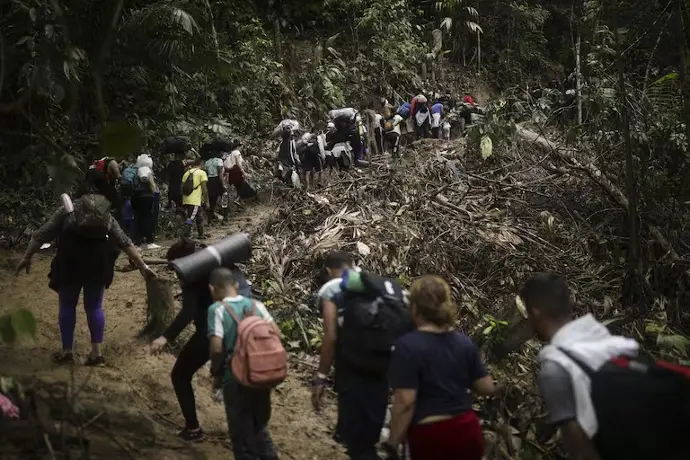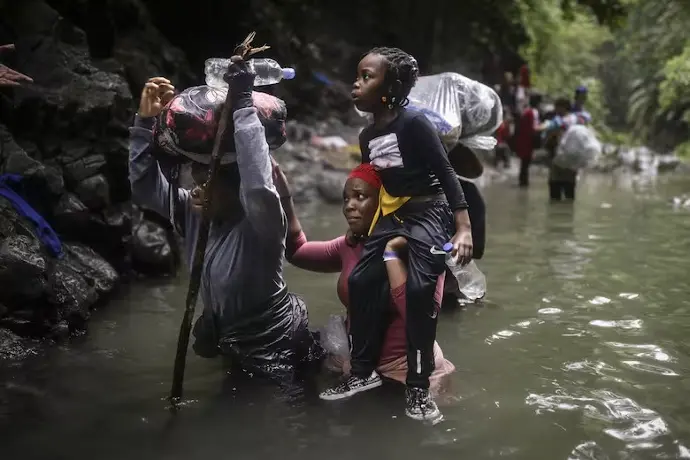The dangerous and dark migration industry of Darien
What is and where is the Darien jungle, the dangerous gateway for many immigrants to the United States.
This deadly route, which crosses parts of Central and South America, is the worst and only option for a growing number of people trying to apply to reach the United States.
The Darien Gap, also known as the Darien Gap, is a vast region of tropical rainforest located between Colombia and Panama. Stretching for approximately 160 kilometers, this territory is one of the most unexplored and dangerous areas in Latin America. Its dense vegetation, wild fauna, and swampy terrain make this jungle a monumental challenge for anyone attempting to traverse it.
On every continent, refugees and immigrants take daily risks to reach the destination where they place their hopes for a better future.
One of the most dangerous routes for them is precisely in the Americas: the Darien jungle, also known as the Darien Gap. It is an area that connects South America with Central America, located between the territories of Colombia and Panama.
Precisely because of its location, the Darien jungle is considered a strategic stretch for those who dream of reaching the United States and building a new life there.
But what makes Darien such a dangerous route? Find out below.
Darien jungle: a challenging territory and dangers that go beyond nature
The Darien jungle has 5,000 square kilometers of tropical forests, rugged mountains and rivers, according to the United Nations High Commissioner for Refugees (UNHCR).
Without money to pay for plane tickets, accommodation and documentation, refugees and migrants risk their lives in the dense vegetation of Darien, the alternative route.
The journey can take up to ten days or more, according to UNHCR. Travelling on foot or using unsafe means of transport (wooden boats, for example), people are vulnerable to temperatures of up to 35º C, dehydration, diseases (such as dengue and malaria), attacks by wild animals and drowning in river rapids.
UNHCR reports that it is common for these people to arrive in remote indigenous communities exhausted and in need of medical care.
However, the Darien Gap also poses dangers beyond nature. The region has become a scene of criminal groups known to commit acts of violence, such as sexual abuse, robbery and human trafficking.
The Migrant Route
Despite the risks, the Darien Gap has become a critical point for thousands of migrants seeking to reach the United States. The journey through this jungle is one of the most dangerous in the world. Migrants face not only the inclement weather and nature, but also the threat of armed groups, drug traffickers and criminals operating in the region.
In recent weeks, much of the debate about illegal immigration to the United States has focused on the south, on the Darien Pass. This treacherous route, which runs through parts of Central and South America, has seen a growing number of people trying to pass through to request asylum in the United States.
The Darien Gap is a stretch of densely forested jungle that runs through northern Colombia and southern Panama. The terrain, about 97 kilometers wide, is muddy, wet and unstable. There are no paved roads in this area. Despite this, it has become an important route for global human migration.
Depending on how much they can afford, people must walk four to 10 days up and down mountains, across rushing rivers and through mud, carrying everything they own—and often children too young to walk—to make it through the pass. Those who make it take buses that traverse most of Central America and head north through Mexico to the U.S. border area.
Cell phone service is disrupted once people enter the dense jungle; migrants rely on paid “guides” and other migrants to get through.
In the decade leading up to 2021, 10,000 people a year took this route on their way north to seek residency in the United States and Canada. By 2023, more than half a million people transited through this part of the Panama isthmus.

Migrants cross the Darien Gap from Colombia into Panama in hopes of reaching the U.S.

Extortion, kidnapping and human trafficking are common in Darien

More than 170 thousand migrants have crossed the Darien jungle in 2024, most of them from Venezuela
Painful numbers
Every year, thousands of people of different nationalities, including Venezuelans, Haitians, Cubans, and Africans, among other countries, undertake the dangerous journey through the Darien. The reasons are diverse, but most seek to escape violence, poverty, and lack of opportunities in their countries of origin.
The journey through the Darien is only the beginning of a journey full of uncertainties. Migrants must face exploitation by so-called “coyotes” (human traffickers), extortion, and in many cases, death. Despite this, the hope of achieving a better life in the United States motivates many to undertake this dangerous journey.
To contextualize the imminent dangers of this transit, there are reports of armed groups ambushing migrants to seize their belongings and steal any money they may have hidden and sewn into their clothes.
Extortion and kidnapping are common. Doctors Without Borders has recently reported an increase in cases of mass sexual assault in which hundreds of people have been captured, assaulted and raped, often in front of their relatives. In December 2023, on average one person was sexually assaulted every three and a half hours during this journey, the same media reported.
Humanitarian organizations and governments in the region are aware of the crisis in Darien. Some aid points have been established along the route, where migrants can receive food, medical care and guidance. However, the capacity of these organizations is limited in the face of the growing number of people using this route.
In addition, the lack of infrastructure and the presence of criminal groups make it difficult to provide effective assistance.
To try to address this serious problem, the U.S. government has implemented a series of legal programs to move to the U.S. and application processing offices in South and Central American countries that give people the opportunity to apply for refugee resettlement and process visas while waiting abroad.
However, the Darien jungle is an inhospitable and dangerous territory that represents one of the greatest challenges for migrants seeking to reach the United States. Despite the enormous risks, thousands of people continue to risk their lives in search of a better future.
The extreme nature of the swamp forest also makes the journey dangerous.
The paths can be very muddy, especially during the rainy season. On mountainous stretches, it is often necessary to climb steep rocks or hold on to a rope to avoid slipping and falling off a cliff.
Many of the people I interviewed who had made the journey saw bodies along the road covered in mud, probably the result of slips or falls that caused their deaths. Other migrants left marks near the bodies, such as pieces of cloth tied to a tree, and took photos of the dead in the hope that this evidence might one day help to recover them.
The rivers are also dangerous. Flash floods and rapids cause many people to be swept away and drown in the muddy waters. Bruises, cuts, animal bites and fractures are common. High humidity and daily heat, combined with a lack of clean water, cause many to fall ill with symptoms of severe dehydration.
Vector-borne, water-borne and fungal diseases are also quite common.
What is behind the recent increase in crossings?
Violence, insecurity and instability in their home countries cause many people to move. They may move to another place in their region. But when the level of violence and insecurity is similar across the country, they continue to move to find a safer place to live.
Legally permitted immigration options are increasingly limited for those living in low-income countries. For example, when governments apply restrictions on travel visas for certain nationalities, this impacts the travel options of people from that country.
In 2021, under pressure from the United States, Mexico began requiring travel visas for Venezuelans traveling to Mexico. This meant that Venezuelans hoping to apply for asylum in the United States could no longer first fly to Mexico as tourists and then present themselves at the border to a U.S. Customs and Border Protection agent to express their fear of returning to their home country.
Venezuelans had to find another route to travel, and for many that route was and remains irregular transit through the Darien Gap without travel documents.
Who is making the journey?
In 2023, of the 520,085 people moving through the region, Venezuelans accounted for more than half, at 328,650. But the total also included 56,422 Haitians, 25,565 Chinese, 4,267 Afghans, 2,252 Nepalese, 1,636 Cameroonians, and 1,124 Angolans. Human migration in the Americas is a global phenomenon. It is also increasingly diverse in terms of gender and age, as Panamanian government figures show. Adult men made up just over half of people moving through the Darien Gap in 2023, and adult women accounted for 26%.
Children under 18 made up 20% of those crossing, and half of them were under 5 years old. Parents may carry children for long stretches of the trip, or children may have to walk even when they are tired. Stress and fatigue increase the likelihood of injuries during the trip.
The Decalogue of Risks in Darién

 IHRO NEWS
IHRO NEWS